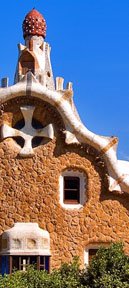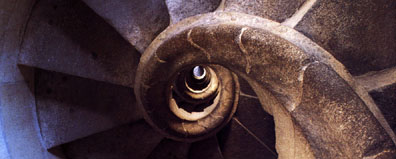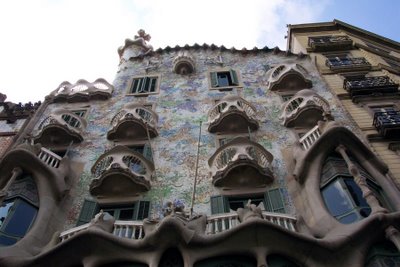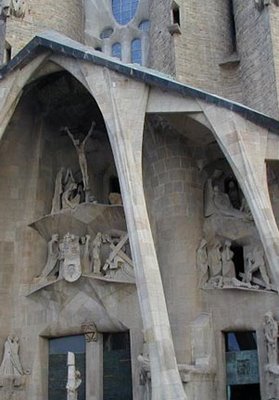Antonio Gaudi (1984)
Remember when you took her to see the church, and you made her leave early? She hates you for that.
 Genre: Experimental Documentary (Japan)
Genre: Experimental Documentary (Japan)Directed By: Hiroshi Teshigahara (Woman In The Dunes; A Stranger's Face)
Overview: This documentary explores the wonders of Spain's most famous architect, Antonio Gaudi.
 Hi Kiddies!
Hi Kiddies!I'll do this one a little differently today, since this film does it's best to circumvent my efforts at the standard five-category rating scale that I'm used to providing. I thought that rather than forcing my paradigm, I'd give this review a more 'organic' approach.
You see, the Spanish Catalan Antonio Gaudi (1852 - 1926) was inspired by nature. All his architectural works, even the most modest contributions, had a strong streak of the organic, be it a leaf-like roof on a row of houses, or a street with all the buildings, roads and sidewalks as merely an element of the whole, so intricately designed that it is seamless, looking like it just belongs.

The film opens up looking at Spain, it's people, then a few moments of shocking and truly incredible martyr art, incorporating all sorts of murals depicting all manners of execution done unto Saints. We are then instantly immersed in Gaudi's works. We see shot after shot of the buildings he created, invented really, and that focus stays until the very end.
 From churches resembling carved-out grottos to pavilions that serve more to delicately accentuate nature rather than defeat it, we see the up-close images and intricate detail of his genius. The wonder of Gaudi is not only in his grand designs, but even in more mundane buildings, as regular downtown streets are graced with his beauty, containing shops and apartments behind the smooth rolling facades looking like cliff faces with tiny burrows.
From churches resembling carved-out grottos to pavilions that serve more to delicately accentuate nature rather than defeat it, we see the up-close images and intricate detail of his genius. The wonder of Gaudi is not only in his grand designs, but even in more mundane buildings, as regular downtown streets are graced with his beauty, containing shops and apartments behind the smooth rolling facades looking like cliff faces with tiny burrows.
The piece-de-resistance, as they say, is the last, his greatest work, still in construction today, the Sagrada Familia, a church that builders hope will be complete 100 years after the Architect's death, in 2026. As expected, it is impressive to watch.
 This film is also inspired by nature. It is voiceless save in the soft sounds of wind through trees, water drops tinkling on ice sheets as they melt, or in symphonies of synchronicity, setting up a mood perfectly chosen for such works. As you watch, you do not learn of a man's life or his tribulations, his inspirations or his friendships, we see simply what nature (in man) has created, and this is why such a film has such a profound effect. The documentary's approach is like going on a hike, observing that which exists, not asking why it was made or what happened to the creatures that lived there. It's a meditative and stunning trip through a life's work.
This film is also inspired by nature. It is voiceless save in the soft sounds of wind through trees, water drops tinkling on ice sheets as they melt, or in symphonies of synchronicity, setting up a mood perfectly chosen for such works. As you watch, you do not learn of a man's life or his tribulations, his inspirations or his friendships, we see simply what nature (in man) has created, and this is why such a film has such a profound effect. The documentary's approach is like going on a hike, observing that which exists, not asking why it was made or what happened to the creatures that lived there. It's a meditative and stunning trip through a life's work.  It comes as no surprise that the director is a man also inspired by nature as one can see from his own masterwork, the Existentialist film, Woman in The Dunes.
It comes as no surprise that the director is a man also inspired by nature as one can see from his own masterwork, the Existentialist film, Woman in The Dunes.There were a few things that distracted, however. Imagine a film with no voices, and with ten minutes remaining, suddenly an old man in a chair speaks of the famous church. After everything that came before, it was out of place. His voice and subtitles interfered with the flow the film had taken, and rather than leaving it soundlessly poetic, it served to explain details that weren't even all that important.
 I also would have appreciated a more organic manner of filming. When I noticed the slow rolling camera coming towards the doors of one of Gaudi's designs, it seemed natural, like I was there myself, and I hoped for this to continue. I wanted long takes of climbing stairs and drifting across halls, in a way similar to Russian Arc. When we followed the long line of seats on the pavilion he created, I wanted the camera to snake across it's edge as the architecture did to the nature it surrounded. From time to time the staccato of the beautiful still images seemed unnaturally machined, and I saw too many lost opportunities to have then mesh in unison. Had this happened I would have been far more moved than I was.
I also would have appreciated a more organic manner of filming. When I noticed the slow rolling camera coming towards the doors of one of Gaudi's designs, it seemed natural, like I was there myself, and I hoped for this to continue. I wanted long takes of climbing stairs and drifting across halls, in a way similar to Russian Arc. When we followed the long line of seats on the pavilion he created, I wanted the camera to snake across it's edge as the architecture did to the nature it surrounded. From time to time the staccato of the beautiful still images seemed unnaturally machined, and I saw too many lost opportunities to have then mesh in unison. Had this happened I would have been far more moved than I was. Overall Rating: 80% (A Nice Tone, Not Gaudy)
 I would imagine that most people, like I did, after being astounded by the works of this man would then tip their hat to those who allowed him to build them. When observing the sights around Barcelona, seeing everything he's done, we're pleased that he was allowed this much creative control. I would not dare say that Gaudi is the only one with this degree of talent, that no one has existed since, with equally brilliant designs, but I do suspect that we need not only praise the governments that allowed this man's works to flourish to such a degree that a city became renowned for being able to contain his art, but we should also inspire other governments to allow such beauty back into their common city streets.
I would imagine that most people, like I did, after being astounded by the works of this man would then tip their hat to those who allowed him to build them. When observing the sights around Barcelona, seeing everything he's done, we're pleased that he was allowed this much creative control. I would not dare say that Gaudi is the only one with this degree of talent, that no one has existed since, with equally brilliant designs, but I do suspect that we need not only praise the governments that allowed this man's works to flourish to such a degree that a city became renowned for being able to contain his art, but we should also inspire other governments to allow such beauty back into their common city streets.

<< Home